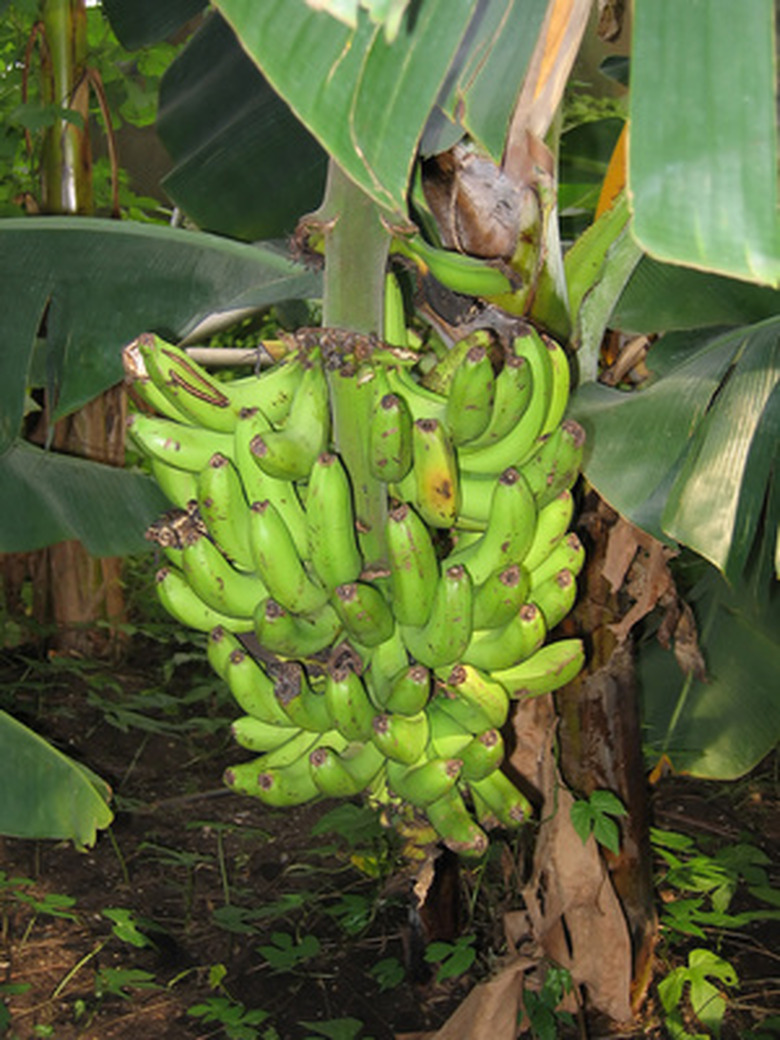How To Prune Banana Plants
Banana plants (Musa) require regular pruning to prevent the banana mat from growing too large and to remove dead leaves and spent stalks from the plant. Gardeners must prune their banana plants regularly, removing both dead growth and new growth as they observe it. Both ornamental banana plants and fruiting banana plants can be pruned in the same manner. Since banana plants only grow in tropical areas, they can be pruned at any time without being left vulnerable to cold damage.
Step 1
Allow the stalk on your banana tree to bear fruit, then harvest the fruit when it's ripe, typically 75 to 80 days after it develops, according to Purdue University. At this time the fruit should be light green. Harvest the fruit by cutting it with a sharp knife.
- Banana plants (Musa) require regular pruning to prevent the banana mat from growing too large and to remove dead leaves and spent stalks from the plant.
- Both ornamental banana plants and fruiting banana plants can be pruned in the same manner.
Step 2
Cut down the stalk that produces the fruit at its base. Once a stalk bears fruit it will never bear fruit again.
Step 3
Chop the cut stalk into small pieces, then scatter then around the base of the banana plant to work as mulch, advises the University of Florida.
Step 4
Thin out the amount of stems produces by your banana plant. The University of Florida suggests having one half-grown stem, one mature stem and one baby stem–called a "peeper"–per banana plant. Cut off extra stems using your knife.
Step 5
Dig out the rest of the unwanted growth using a small shovel, or stab it with a sharp trowel. If you simply cut off unwanted growth, it will regrow very quickly.
- Cut down the stalk that produces the fruit at its base.
- Cut off extra stems using your knife.
Step 6
Prune off dead leaves on the banana plant, which will be tan-colored. To allow the fruit to develop properly, prune away leaves that rub up against the fruit cluster. Banana fruit requires sun to ripen.
Banana Plants And Irrigation
Place banana plants in full sun. To ensure adequate temperatures for optimal growth, you can plant bananas near a building or paved driveway or walk, which hold the sun's warmth. Bananas grow best in rich, well-draining soil with a pH between 5.5 and 6.5. Add a hefty layer of mulch on top of the soil to help retain moisture. Inadequate water can lead to slow growth and small fruit. The banana's large leaves require a large amount of water to remain healthy. Look for low-volume sprinklers that spray water at a low trajectory angle of 9 to 14 degrees. Give banana plants a deep, slow watering every two to three days when the weather is warm and more frequently, if needed, during droughts. Make sure the soil drains well and does not have standing water.
- Prune off dead leaves on the banana plant, which will be tan-colored.
- To ensure adequate temperatures for optimal growth, you can plant bananas near a building or paved driveway or walk, which hold the sun's warmth.
Things Needed
- Sharp knife
- Small shovel
- Small trowel
